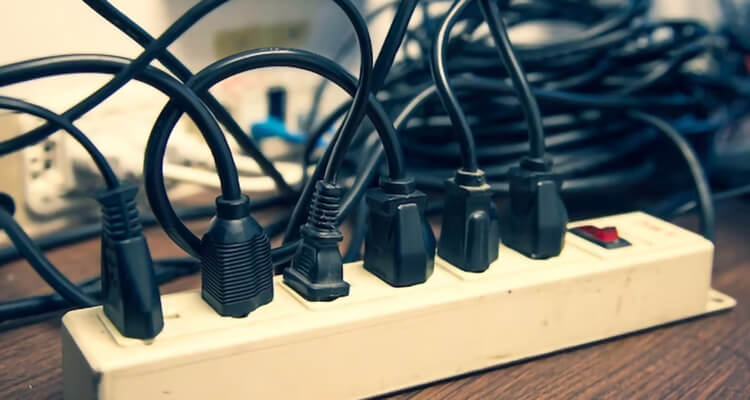How to Find a Short Circuit With A Circuit Short Finder
We’ve often heard about “short circuits” in movies. If lucky, this will be a term we see on screens. But sadly, it happens to us quite often. It’s common in old houses or when we have massive electricity usage at a time.
When a short happens to our home wiring, a circuit must break down. Relatively, the connected bulb, outlet, ACs, heating tube, or other appliance is no longer available. If we want to make the circuit and the appliance work again, finding and fixing the short circuit wiring is a must.
To many people, having a short circuit seems to be a big issue. Take it easy, it’s a common electrical problem. We can deal with it at home. In today’s tutorial, we'll delve into the world of short circuits, exploring their causes, and effects, most importantly, how to find and repair a short circuit wiring.
- Part 1: What is a Short Circuit
- Part 2: What Causes A Short Circuit
- Part 3: What Will a Short Circuit Do to Safety
- Part 4: How to Find a Short Circuit
- Part 5: How to Fix a Short Circuit
Part 1: What is a Short Circuit
A short circuit (or just “short”) is an electrical wiring problem that happens quite often.
Formally, a short circuit refers to a situation in which currents follow the path that has the lease resistance instead of the preset expected circuit.
In other words, an accident happens and the electricity flow goes into the wrong path.
Cases in point:
- Neutral, hot, and grounding lines are in the wrong connection.
- The copper parts of two different make contact.
- Water has much lower resistance than electrical copper wires. If there’s water in the wire or connected plug, the current will follow the water instead of the wires.
- Massive currents make the circuit overload.
Part 2: What Causes A Short Circuit
A short circuit may result from multiple causes.
When the components to mount wires, outlets, breakers, and switches loosen, the hot and neutral lines make contact. Currents go to the wrong path and the circuit is incomplete.

Or, this is a big mistake. When installers set up the wiring in your place, they placed the hot line into the wrong phase. So, a short happens when you insert a plug into this outlet. The current cannot flow right away.
Moisture
Drops, rains, cat or dog pees, and other water will seduce the power to the liquid and skip the correct wire.
Broken insulation
There is a layer of rubber insulation warped around a copper wire. If the insulation is gone, the copper wire may make contact with another copper wire, water, or other metal objects.
What causes the broken insulation? There are a lot.
- Wear and tear;
- Bites and scratches of rats, cats, dogs, squirrels, and raccoons;
- The wire is barely enough long for this circuit and it’s always in tension;
- Deterioration because of light(sunlight mostly), heat, or oxygen;
- Chemical corrosion.
Overload circuit
If the electrical components cannot process the power going through, the circuit overloads and a short occurs.
The common reason why there’s over-capacity power is too many active appliances. When you connect multiple demanding appliances (microwave, oven, refrigerator, & electric kettle ) into one socket and launch them all at the same time, the required current is unbearable to the socket. It overloads and the wire heats up. The socket will spark and stop working.

Also, there’s a rare case: thunder and lightning.
Lightning brings high-voltage electricity. And if it hits buildings and lines, the power will overwhelm the wires. Even though the lightning doesn’t hit the electric components, it affects the electromagnetic field. This will cause a power surge - the voltage changes.
Part 3: What Will a Short Circuit Do to Safety
There are two potential risks of a short circuit: fire and electric shocks.
As mentioned, a short happens when power fails to flow the preset path. An unbearable current rushes into one wire. This heats the wire. As the short continues, the temperature of the wire gets higher. Finally, it burns out the insulation layer. Fire starts.

Besides, when a short happens, a circuit is incomplete. The currents cannot go to the right end. They may go anywhere you can’t imagine like outer cases of appliances and switches.
When you turn on or touch a device connected to a short circuit, you get shocked by the escaped electricity. If the voltage is high, you get injured and killed.
Part 4: How to Find a Short Circuit
To reduce the change of fire and electric shocks, let’s find the short circuit in the home wiring.
For beginners, this may sound difficult. Don’t worry, check on the methods below and we can easily find the short point.
Method 1: Check for burns and smells
There is one easiest way to tell the short circuit: find the burns and smells of burned plastic around the wires, sockets, and breakers.
The copper wire will get hotter as the short continues. When the temperature is high, it burns the insulation, outlet cap, socket case, switch, and even the circuit breaker.
So, look at these electrical components for any signs of burning. If there’s a blackened and deformed outer, there’s a short circuit.
Method 2: Find a short circuit for a wall outlet
If a wall outlet is not working, let's assume it’s short.
To prove this, we need a socket tester. Plug the socket tester into the outlet. And start a quick wiring test for the outlet.

Tip:
Some electricians will use multimeters to test the wiring of an outlet. We don’t recommend beginners doing so. This requires techniques. And it’s very dangerous.
Method 3: How to find a short circuit with a wire short finder
When the short happens in the middle of the wire, it’s pretty hard to find it by just looking. We need help from professional tools.
Here, we will use a wire short finder, the NOYAFA NF-826 Cable Locator.
This is an all-in-one wire fault locator. Once attached, it can help find the open, short, and break in a circuit with a probe and tone generator.
How it works:
It sends magnetic signals to the attached wire. The probe detects the signal as it gets closer to the wire and beeps. Where the beep stops, that is the short.

By emitting and receiving the signals, NF-826 can scan a short circuit even if it hides inside a drywall or below the floor.
Not just for indoor circuits, NF-826 works for outdoor electric wiring and underground circuits like dog fences and sprinkler system. No more struggle to find a short with naked eyes. Save your time and effort without destroying the wall, floor, and yard.
Now, get NF-826 and add it to your electrical toolbox. Let's start to find the short circuit in your home wiring.
Steps to find a short wiring with NF-826
Step 1: Get the short circuit detector ready
Unbox NF-826 and take out the Emitter device along with adapters and tester pins or clamps. Connect the pins or clamps to the Emitter via the adpater cables.
Tip: Pins or clamps?
If the short makes an outlet disabled, pins will help. We can plug them into the outlet later. Or the circuit is for a bulb or other appliances, we need the crocodile clamps.
Step 2: Attach to the circuit
Before we start, turn off the power of this circuit. There are chances that this circuit still carries electricity even if it has a short.
Go to the circuit breaker box and switch off the related breaker. Have no idea which one? Turn off them all for just a while.
Now, attach NF-826 to the target circuit.
Case 1:
If it's connected to an outlet, plug the two pins into the two prongs: red to the right and black to the left.

Case 2:
When a switch controls the wire, uncap it to expose the wire(s).
- One wire only? Use the red clamp and leave the black one to the ground or wall.
- Two or more wires? Clip the red one to a red, yellow, blue, or brown wire. Connect the black clamp to a green wire.

Case 3:
If it's an ourdoor circuit, install the ground rod vertically into the earch (find it in the package). Clip the black clamp to it. Attach the red clamp to the wire.

Step 3: Find the short
Power on the Receiver device. Start to trace the wire by moving the probe close to the wall or ground.
You will know where this circuit goes behind the wall or underground with the tone.
Where the sound stops is the short point. Done!
Part 5: How to Fix a Short Circuit
If you have zero experience, we don't recommend you fix a short circuit at home without the assistance of professionals. Please contact an electrician for the repair.
If you do have experience of electrical wiring or repair experiences before, try this to fix the short wiring at home.
Step 1
Turn off the power supply to the affected circuit at the breaker box. This prevents the risk of electric shock while you work.

Step 2
Carefully uncover the wires after identifying the location of the short. Uncap the outlet. Drill holes in the wall. Or dig in the garden.
Carefully cut out the affected section using wire cutters. Strip the insulation from the ends of the wires. Twist the copper wires together.
Or, you can replace a wire.
Step 3:
Wrap the connection area with electrical tape. If possible, add some protectors like a tube, sleeve, etc.

Step 4:
If there's any component like an outlet or switch is damaged due to the short, replace a new one.
Step 5:
Put everything back like they used to be.
Step 6:
Restart the power and monitor any signs of a short.




